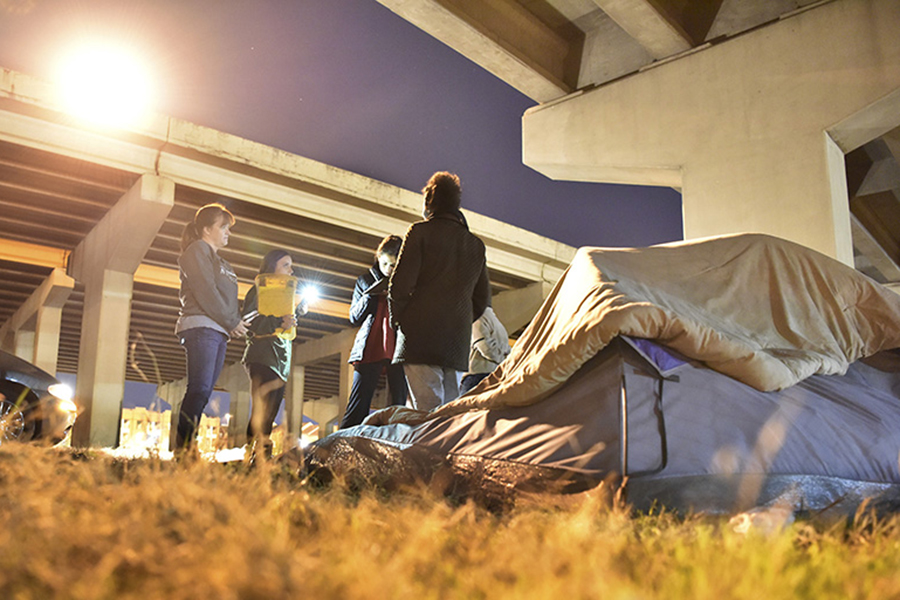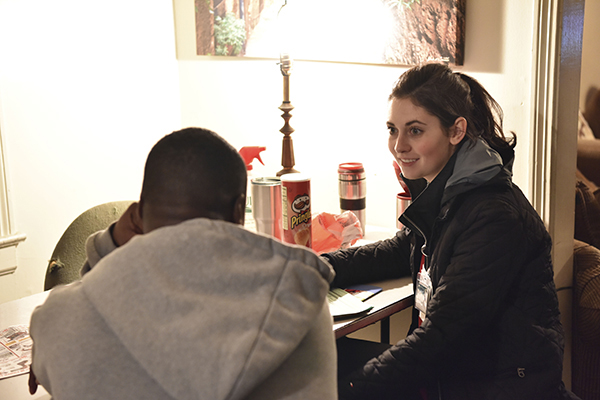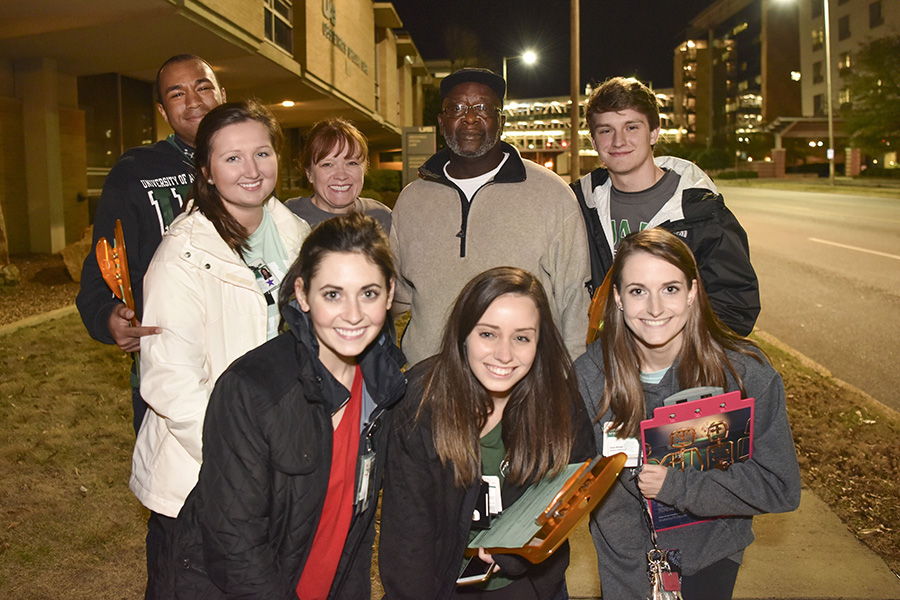 As part of the annual Point in Time census of the Birmingham homeless community, Dr. Sallie Shipman, left, and students from the School's NUR429L Concepts of Community and Public Health Nursing class speak with a young woman they met living in a tent under one of the city's overpasses.By Staff
As part of the annual Point in Time census of the Birmingham homeless community, Dr. Sallie Shipman, left, and students from the School's NUR429L Concepts of Community and Public Health Nursing class speak with a young woman they met living in a tent under one of the city's overpasses.By StaffAt first glance, there was nothing unusual about the young woman who responded to the shout of a greeting.
Her clothes were neat. Her hair was well-groomed. Her smile was beautiful.
At first glance, she looked like an upwardly mobile business professional headed home from the office or out for a night on the town.
In reality, she had just emerged from a sky-blue pup tent pitched beneath an overpass on the city's north side -- a small, flimsy shelter on a hardscrabble piece of ground that she called home.
As she talked with her visitors, the young woman -- one of approximately 1,200 homeless individuals who regularly live in Birmingham's cracks and crevices -- served as a stark reminder of a societal problem that many see yet don't truly realize its scope or effect.
For University of Alabama at Birmingham (UAB) School of Nursing students in the NUR429L Concepts of Community and Public Health Nursing class taught by Assistant Professor Sallie Shipman, EdD, MSN, RN, CNL, that reality was driven home as they participated in the Point in Time homeless community mini census.
Point in Time is an annual canvas of the metro Birmingham area to gather valuable information about the homeless community in central Alabama, and is vital for understanding demographics, tracking trends, identifying gaps in community services and planning future work in the fight to end homelessness.
It depends on community volunteers, such as Shipman and her NUR429L students, who in conjunction with experienced street outreach workers affiliated with the One Roof organization, venture out across the city to find and focus on homeless individuals and their plight.
Deep in the shadows, with the bright lights of the Birmingham skyline as a backdrop and the whiz of cars and trucks on the roadway above the sound track, the School’s students learned lessons about an underserved population that are hard to come by in a classroom.
"If you would have seen her on the street walking by in daylight, you would have never known she was homeless," fourth-semester nursing student Dylan Yaeger said. "There was just no way you would have ever known she lives like that every day. It would be like seeing me at school and never realizing I was homeless."
Yaeger's classmate, Christen Cline, was equally impacted by the exchange.
"She was very young and sweet," Cline said. "She was the polar opposite of the image that people have of homelessness. She was very kind and it was a great experience to meet her, but it was sad because she was so isolated and alone."
YOU SEE THEM, BUT YOU DON'T
For this latest Point in Time census, conducted on a chilly late January evening, the students' guide was Melvin Harris, an employee of the Firehouse Shelter, a men's homeless shelter that runs programs and offers affordable housing at 16 different locations across Birmingham. Harris is also a true veteran of the streets, having been homeless himself for eight years in the late 1980s and early 1990s.
He knows Birmingham's backstreets and alleyways because he's lived on them and because he now regularly takes to them trying to provide the same help he received long ago. Amazingly, he knows of some from his homeless period who are still on the streets.
"I was homeless with a lot of people and some of them are still out here for whatever reason, and I want to help them like I was helped," Harris said. "God has blessed me to get my life back together again, and I have been able to grow spiritually, mentally and physically. I've got a new family, a wife and son. I am very blessed.
"Now God is allowing me to give back, and I am very proud to be able to show the students where these people live and who they are."
What the students found may have surprised them, Harris said.
"The homeless are good people. Kind people," Harris said. "They have just been on hard times for some reason, and they need to be treated with dignity and respect just like everybody else.
"We pass by these bridges and abandoned buildings, we pass people on the street that look pretty normal, and we don't pay it much attention. Little do we know that the people we are walking past are homeless. We see all these people, but we don't really see them."
On this night, Harris started with a visit to a man who had set up camp under a downtown overpass. The man listened to Harris but declined to participate in the survey, saying the last two times he did so he was forcibly removed from his homestead within days.
Next came a winding trek down a rough, rocky dirt road to a location near the railroad tracks in the city's center to check another area where homeless individuals often congregated. As the students asked one man survey questions, several sharp whistles of a freight train rumbling past nearby pierced the night.
Then it was on to the next venue, which made as lasting an impression as any on the evening.
NOWHERE ELSE TO GO
Following Harris' lead, Shipman and the students took a well-beaten path beneath the overpass to a large hole cut into a chain link fence. Passing through that, they entered a world of litter, debris and more lost hopes and dreams than they may ever have imagined.
On their first stop, a homeless man who identified as a Veteran agreed to participate as long as he didn't have to stand up to do so. As two students squatted to speak with him, the man answered the first few questions then drifted off into a discussion about current events and politics. After much circling back, the students were able to complete his survey.
 Christen Cline asks a resident of one of two shelter homes the group visited survey questions to compile information on homeless individuals in the Birmingham area for the Point in Time census.Then they moved a few hundred yards north and approached the blue pup tent. After appearing tentative to respond to Harris at first, the young woman soon seemed to warm to the conversation and the companionship. As she spoke with the group, nearby Harris shared some of the details of her story.
Christen Cline asks a resident of one of two shelter homes the group visited survey questions to compile information on homeless individuals in the Birmingham area for the Point in Time census.Then they moved a few hundred yards north and approached the blue pup tent. After appearing tentative to respond to Harris at first, the young woman soon seemed to warm to the conversation and the companionship. As she spoke with the group, nearby Harris shared some of the details of her story.She has long suffered from anxiety and extreme claustrophobia, which particularly manifests itself when she tries to live indoors. She has had difficulty maintaining interpersonal relationships and at times has had to leave different shelters after becoming agitated with other residents. In reality, she has nowhere else to go.
"It makes you realize that you're only one paycheck away from being homeless yourself," said Harris, who watched as the young woman accepted an offer of bottled water and snacks. "You lose your job, lose your finances, lose your way, you could be homeless just like that with nowhere else to turn."
Yet standing there in the midst of despair, Harris was filled with hope for the future. It is hope based on ideas and actions, and the next generation of leaders like the UAB School of Nursing students.
"We've got these young people with their fresh minds who are open to new ideas and not afraid to take chances," Harris said. "They're willing to go into the underbrush, under the bridges and overpasses, things like that to try to help.
"It lets me know that we have got a chance of life getting a whole lot better on these streets and in our community."
PARTNERSHIP IS IMPORTANT
The student group went on to visit two shelter homes, one all male and one all female, giving them well-rounded insight into the numerous avenues of help available to homeless individuals in the area.
At each stop, the students enthusiastically asked the survey questions. In turn, many of the interviewees were noticeably excited someone had stopped to talk with and learn more about them.
"I am so thankful they allowed us to interview them and that they took the time to talk to us," Cline said. "I thought it was very kind of them, and I really enjoyed it."
The few minutes each student spent with a homeless individual were of immeasurable benefit to One Roof in its efforts to unite Central Alabama to end homelessness, said One Roof Community Outreach Coordinator Courtney Stinson.
"Point in Time gives us a snapshot of what our homeless community looks like on any given night," Stinson said. "Our partnership with the UAB School of Nursing is especially important because nursing students will go on to serve this very population as professional nurses. Getting that one-on-one interaction and getting to see some of the real issues impacting the homeless community is important to their career development, and it helps us tremendously.
"By participating in Point in Time, they get to see what life is like on the streets and, we hope, realize that homelessness is not a condition, it is an experience someone is having."
"THIS IS WHERE I NEEDED TO BE"
Before she began teaching the NUR429L course in 2014, Shipman had not worked much with the homeless community. After partnering with organizations like One Roof and the Firehouse Shelter and participating in events like Point in Time, she has "such a heart for them now."
By teaching one of the courses that puts into practice the School's mantra of "think globally, act locally" Shipman is opening the eyes and shaping the minds of her students in numerous ways.
"I cannot put into words the difference I have seen in my students since I was given the opportunity to teach in this course," Shipman said. "The way it changes their perceptions, their ideas and, in many cases, their entire approach to the health care profession truly has to be seen to be believed."
Shipman related the story of one her early students in the class who was initially unhappy she had been assigned to work at the Firehouse Shelter.
"She was actually upset at me for putting her there because she wanted to work in maternal child," Shipman said. "At midterm she told me 'Dr. Shipman I was really mad at your for putting me here at first, but I realize now this is where I needed to be.' Just that quickly she realized how different it is with the homeless population and how much impact she could have as a nurse working with that population. It was very satisfying to see."
SEEING IS UNDERSTANDING
Their brief time spent helping with Point in Time changed the students' perceptions in many ways.
"I imagined it would be a lot of different tents set up together in a few places," Amber Puckett said. "I didn't really picture it being a lot of people off by themselves like we saw. That was really different from what I expected."
Classmate Matthew Palmer agreed.
"There were some even set up in fields and places like that. It seemed like those places were a lot more open than anyone would ever want to be," Palmer said.
It was good for the students to see and grasp the stark realities of life on the streets first-hand, Harris said.
"You can tell someone what's going on, but it's a whole lot better when you can bring them out and let them see it for themselves," Harris said. "These people that they met on the streets and under the bridges are the same ones that will come into the hospitals and the clinics when they move onto their careers. When they do come in, these students will understand them much better.
"My heart is filled with joy because I realize I am not out here by myself, and I've got some help on the way."
 Members of the team from the UAB School of Nursing that participated in the 2017 Point in Time census of Birmingham's homeless community were, front row from left to right, Christen Cline, Melissa Dunn, and Grace Morgan, middle row, Amber Puckett, Melvin Harris from the Firehouse Shelter and DylanYaeger, and back row, Matthew Palmer and Dr. Sallie Shipman.
Members of the team from the UAB School of Nursing that participated in the 2017 Point in Time census of Birmingham's homeless community were, front row from left to right, Christen Cline, Melissa Dunn, and Grace Morgan, middle row, Amber Puckett, Melvin Harris from the Firehouse Shelter and DylanYaeger, and back row, Matthew Palmer and Dr. Sallie Shipman.